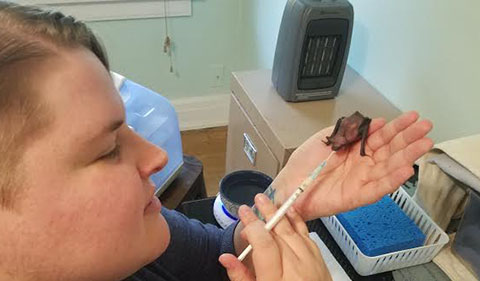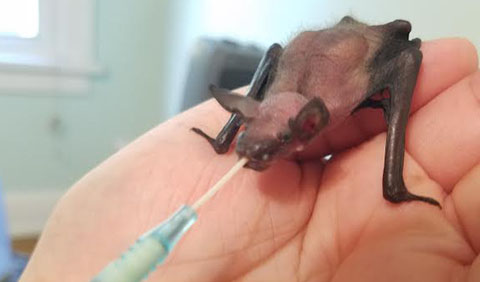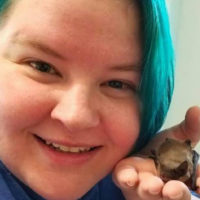
A.P. Feeney feeding young bat Bartok with syringe
During A.P. Feeney’s sophomore year as an Anthropology student at Ohio University, she interned at Yellowstone National Park’s Tribal Relations Department and was later a private contractor for a summer with them.
“There I worked on several projects designed to incorporate tribal knowledge of Yellowstone’s natural resources and wildlife,” she says. “One of the biggest (and what I’m proudest of) was a report I complied on the traditional, practical, and spiritual uses of bison for all 80 Native American tribes that are associated with Yellowstone.
“After graduation I was lucky enough to be accepted to a couple different graduate programs (including OHIO’s International Development Studies and Exeter’s Anthrozoology program). However … I decided to make my own way working from the bottom up.”
In May she began volunteering for Stark Parks’ Wildlife Conservation Center, and in June she began her training to become a sub-permitted Wildlife Rehabilitator specializing in bats.
“This means that, once I complete my training, I will be permitted under WCC’s wildlife rehabilitator permit on both the state and federal level, Feeney says. “To get to that point, I had to take a Rabies Vector Species training from the Ohio Wildlife Rehabilitators Association and spend time being mentored under an established rehabilitator who works with bats.”

Young bat Bartok in A.P. Feeney’s hand while she feeds him with a syringe
This summer she received two Big Brown bats to work with—Allister and Bartok.
“Allister came to me extremely undernourished and unfortunately died within a couple weeks, but I’ve had Bartok since he was 4 grams, and he is now a healthy 15 grams!

“My home facility is very small and minimally equipped at the moment; however, in the future I hope to expand to include equipment such as an incubator, pre-flight, and flight cage.
“Unfortunately, a huge issue facing rehabilitators is that this important local conservation effort is considered a ‘hobby,’ which means all rehabilitators who do not directly work for an established facility are volunteers—and rehabilitation is not a cheap endeavor.
“I believe wildlife rehabilitation should be recognized for the valuable grass roots conservation effort it is. I am incredibly lucky that my amazing wife is so supportive!”
Feeney decided to started a blog in order to both document her own home facility as well as post conservation and rehabilitation articles from her perspective. “The realms of both academia and science have been a closed privileged bubble for long enough,” she says. “Conservation can be something that is not only accessible to everyone but can actually improve local environments and ecosystems.
“Everything is still in the beginning stages; my goal is to make Thrive Wildlife Conservation a non-profit and expand into educational programs and local wildlife conservation activities.”



















Comments